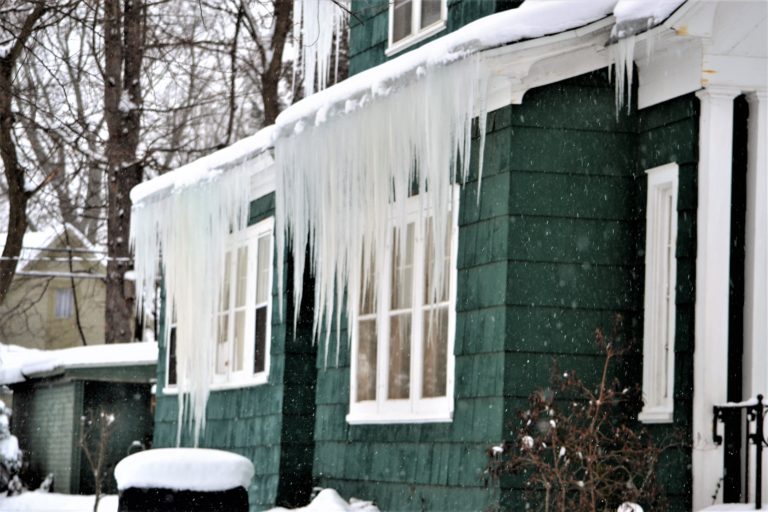With an uncommonly warm October upon us, it may be easy to forget that winter weather isn’t far off. 2021’s winter storms took many unaware, and the outlook for this upcoming winter predicts similar freezing temperatures and increased snowfall. The wintery mix that’s expected to arrive can present dangers to your roof in the form of ice dams. You may have heard the term in passing, and found yourself wondering, what are the actual dangers ice dams pose to your roof? And how do you avoid letting ice dams create a scenario where they require a roof replacement in Maryland? Let’s break it down.
What Are Ice Dams and How Do They Form?

Ice dams are a meteorological phenomenon that occurs most often on roofing systems. This blockade of ice forms when the upper portions of your roof remain at a temperature above freezing while the lower edges remain at freezing or below. Because heat rises within your home, your attic space can accelerate this process, especially if it doesn’t contain a proper layer of insulation between the attic and the home’s interior. These uneven temperatures produce a scenario where water from the upper roof melts down the surface of the roof. However, it becomes trapped by the frozen liquid barrier at the roof’s edge, creating an ice dam. This problem is exacerbated when fresh snow packs the liquid and ice together. Ice dams can because by particularly nasty winter weather mixes, but most often are the result of an attic with an insufficient ventilation system, trapping hot and creating a temperature discrepancy between the upper and lower parts of your roof.
What Are the Dangers Ice Dams Pose to Your Roof?

Ice dams a grave concern for your roofing system, as they can cause dramatic, and costly, damage. Firstly, the accumulated weight of the ice dam can result in your roof’s gutter system breaking off. The gutter system is an integral part of your roofing system, allowing excess water to drain off, and if it’s damage, it can compound the problem of ice dams. Secondly, there’s the risk of the ice tearing shingles from your roofs. Shingles are a protective layer that keeps your roof durable and dry. Torn-off shingles can create additional areas for moisture entry. However, the biggest risk of ice dams is the way they collect water. When water pools on your roof with no where to properly drain, it can create permanent damage to a roof. Sitting water can seep into the interior wood of the roof, and through towards your attic. Moisture damage in a roof and attic system can be devastating, possibly necessitating a full roof replacement. These dangers ice dams pose to your roof can be catastrophic for your home and wallet, creating a scenario where an MD roof replacement isn’t out of the question. As such, it’s important to be proactive and take preventative measures.
How to Prevent Ice Dams from Forming
There are several steps you can take, that with the help of an expert, will prevent damage from ice dams and save you from significant damage to your roof. The first step is to address ventillation in your attic. A roofing professional can inspect your attic and give you an action plan to address heat that becomes trapped. Ventilating the attic properly can help prevent excess moisture from melting on the upper roof. Next, it’s time to address proper gutter maintenance. If you wait too long after a winter storm without cleaning your gutters, they’re susceptible to be built up with ice and break off from your home. A thorough post-storm cleaning by professionals is a great way to ensure the integrity of your gutter system. Lastly, talk with a qualified roofing company about whether ice guards would be the right option for your home. Ice guards help prevent excess snow and ice from building at the base of your roof, stopping ice dams from ever forming.
The dangers ice dams pose to your roof should not be underestimated. But if you work with a quality roofing company like Four Twelve, you have the opportunity to take proactive steps to stop ice dams from forming and causing catastrophic damage to your roofing system. Contact us today to get started on your ice dam prevention before the winter weather arrives.







